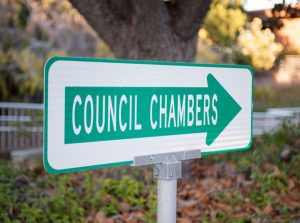Draft Preservation Ordinance Continues to Move Forward
Last week a Santa Clara City Council study session took a look at a draft historic preservation ordinance that has been over a year in the making. The ordinance defines a process and qualifications for designating historical resources, and considerably expands the power of the Historical and Landmarks Commission (HLC). The draft is now under review by the Planning Department, which will return to the Council with its recommendations.
Almost everyone agrees that Santa Clara’s present process, with no established rules for alteration and renovation of “old” properties except for those with state and federal tax exemptions or public funding for preservation, direly needs renovation itself.
The draft spells out what can be considered for Santa Clara Historic Resource status, the process for making that determination, permits required for alterations of historic properties, preservation incentives, hardship considerations, and penalties for illegal changes and demolitions. The regulations apply principally to exteriors.
History, Like Beauty Is Often In The Eye Of The Beholder
Federal and state laws define what can be considered historic, how it’s to be treated, tax and financial incentives for preservation, and designations for the National and State Registers of Historic Places – and many Santa Clara landmarks are already on those lists. But preserving local history is largely the responsibility of local governments. And deciding what is “historic” has been the waterloo of previous Santa Clara attempts to pass preservation ordinances.
Once upon a time, anything more than 50 years old might reasonably be considered “historic.” But now many of Santa Clara’s housing tracts south of 101 are 50 years old. Are they all historic? In addition to the18th, 19th and early 20th century structures, mid-20th century architecture such as Eichler and MacKay tracts are now considered potentially historic resources.
For many, post-WWII suburban tracts epitomize conformist mediocrity – a 1962 song called them “Little boxes made of ticky-tacky… [that] all look just the same.” But for future generations, who will live their lives in considerably higher-density housing – at least in the Bay Area – 1960s suburban tracts might hold as much history and charm as blocks of San Francisco Victorians.
Despite the many questions yet to be answered, the good news is that unlike 50 years ago – when New York City allowed demolition of the Beaux-Arts masterpiece Penn Station and the wrecking ball hit Santa Clara’s downtown – these questions are being asked.
Defined Processes, But a Lot of Power to Unelected Commission
The draft lets owners, the City Council, and the HLC propose properties for historic resource status. The HLC will then recommend approval or denial to the Council. However, nothing can be designated historic without the owner’s consent.
This may seem like giving owners veto power over preservation. However, anything construed as taking away private property rights would be unlikely to get a majority vote from the Santa Clara City Council. Council Member Lisa Gillmor said she was already “concerned about [the ordinance] going too far … and taking away property rights.”
The draft empowers the HLC to review any major project on anything that might be significant historically, culturally, architecturally, geographically, archeologically, or for its natural characteristics. (See accompanying process chart).
Major renovations to historical properties, and properties eligible for historical designation, would require a Significant Property Alteration (SPA) permit approved by the HLC. Denials could be appealed to the City Council. This is a significant expansion of the HLC’s powers, without any corresponding expansion in the qualifications required to serve on the commission – which is simply being a registered Santa Clara voter.
The ordinance also creates a new category of “small projects” requiring review, but which can be approved by the Planning Director without HLC review. These eight categories include repainting with “acceptable color schemes,” replacing roofs with identical materials, and “removal of any materials that may be part of the character-defining features or historic fabric of the historic resource.”
Failure to maintain a property by the current or previous owner – in other words, buying a property with the sole purpose of demolishing it – is considered “demolition by neglect” and subject to penalties, as well as disqualifying the owner for hardship and other financial considerations.
This cast too wide a net for G’illmor, who said the Council should “think very hard” about giving so much authority to a body that’s appointed, not elected. “There’s a large parts of the city that’s going to have an effect on, people who have no idea about this. There’s a huge amount of outreach that’s needed for other parts of town besides the Old Quad.” And, she added, “I don’t think there’s been any outreach to the real estate community. We have very strict disclosure requirements.”
The ordinance also applies to non-historic properties that are within 300 feet of historic resources. This opens up the question of historic districts and whole neighborhoods. It’s intuitively clear that a single Eichler house sandwiched in between zero lot-line McMansions is different from a tree-lined street of Eichler houses. However, defining the boundaries of an historic district or neighborhood is far less straightforward.
If all of these neighborhoods are going to be considered potentially historic, Gillmor said, the City needed to be proactive in making sure that residents understood the new law, and informational meetings needed to be held in those neighborhoods, rather than City Hall.
Council Member Debi Davis expressed a concern that some of these definitions – for example, demolition by neglect – were fairly subjective.
Another concern was too much specificity in the ordinance, said Mayor Jamie Matthews, adding that he would prefer to see details – such as allowable exterior paint colors that can be approved routinely – in appendices that could be modified than in the ordinance itself.
“The more rules you put in place …. the more opportunity for unintended consequences,” he said. “We have to be careful not to create a disincentive [for owning designated historic property]. There has to be some value for owners.”
Matthews pointed out an unintended consequence that’s already surfaced. City Manager Julio Fuentes, whose experience and insight is key in the Council’s deliberations, had to be recused from the discussion because he lives within 300 feet of an historic resource – a cemetery – and would be affected by the law even though his house is 15 years old.
Find the current draft of the ordinance at http://tinyurl.com/historic-ord.











0 comments